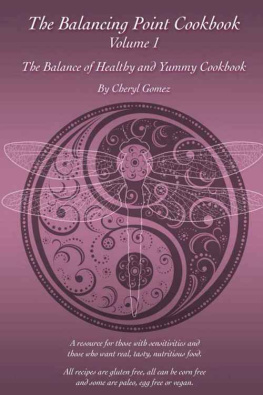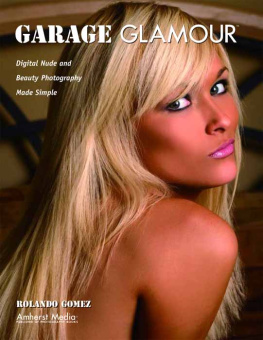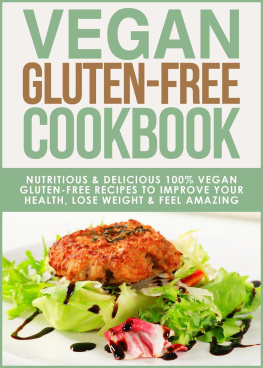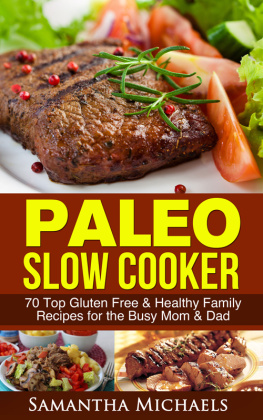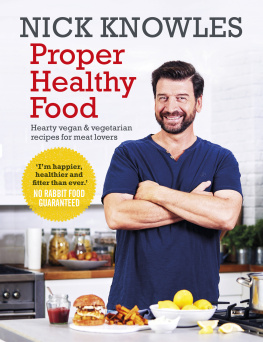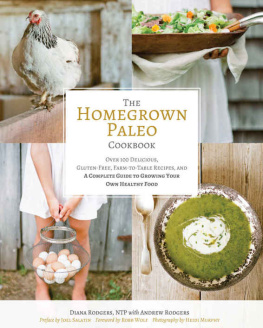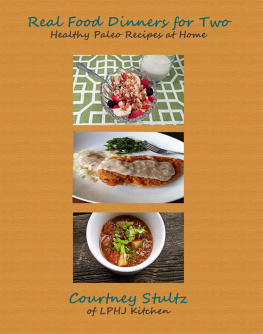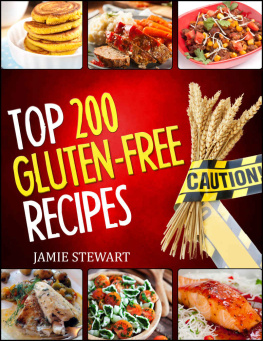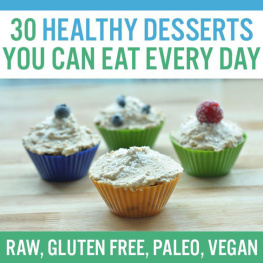Gomez - The Balance of Healthy and Yummy
Here you can read online Gomez - The Balance of Healthy and Yummy full text of the book (entire story) in english for free. Download pdf and epub, get meaning, cover and reviews about this ebook. year: 2015, genre: Home and family. Description of the work, (preface) as well as reviews are available. Best literature library LitArk.com created for fans of good reading and offers a wide selection of genres:
Romance novel
Science fiction
Adventure
Detective
Science
History
Home and family
Prose
Art
Politics
Computer
Non-fiction
Religion
Business
Children
Humor
Choose a favorite category and find really read worthwhile books. Enjoy immersion in the world of imagination, feel the emotions of the characters or learn something new for yourself, make an fascinating discovery.
- Book:The Balance of Healthy and Yummy
- Author:
- Genre:
- Year:2015
- Rating:5 / 5
- Favourites:Add to favourites
- Your mark:
- 100
- 1
- 2
- 3
- 4
- 5
The Balance of Healthy and Yummy: summary, description and annotation
We offer to read an annotation, description, summary or preface (depends on what the author of the book "The Balance of Healthy and Yummy" wrote himself). If you haven't found the necessary information about the book — write in the comments, we will try to find it.
Gomez: author's other books
Who wrote The Balance of Healthy and Yummy? Find out the surname, the name of the author of the book and a list of all author's works by series.
The Balance of Healthy and Yummy — read online for free the complete book (whole text) full work
Below is the text of the book, divided by pages. System saving the place of the last page read, allows you to conveniently read the book "The Balance of Healthy and Yummy" online for free, without having to search again every time where you left off. Put a bookmark, and you can go to the page where you finished reading at any time.
Font size:
Interval:
Bookmark:

 Corn
Corn  Free *
Free * 


Food is meant to nourish, repair, and replenish us. It can help us be healthy and energetic, or it can contribute to inflammation, disease, or just keep us from having the clarity and energy to actualize the full experience life is offering us. We should feel good, satisfied, and fulfilled during and after we eat. Too often we are left feeling uncomfortable: physically or even emotionally. Even a food that has been categorized as healthy can sometimes, in quantities too large, be harmful, or be a food which is not optimal for our unique body. This is part of our journey-owning our uniqueness and honoring and choosing to act upon it. We are making powerful choices every time we put something into our mouths. Lets choose well!
These recipes are quite flexible, adaptable, and forgiving. I have created and/or modified them for my sensitivities, tastes and as a fun creative venture. Feel free to substitute some of my more unique ingredients with more conventional ingredients or with whatever you have on hand. But do gradually add to your cupboards some of these superfoods which have so much to offer us in terms of flavor and nutrition. Everything is assumed to be organic- do your best here- it is worth the price for the qualityingredients as well as to be a good steward of our planet.
These recipes are corn-free unless you use baking powder which contains corn starch. You can substitute that with cream of tartar and baking soda anywhere from 2:1 to a1:1 ratio. Vanilla extractboth the alcohol based and non-alcoholic (glycerin) basedcontains corn. Vanilla powder is just vanilla beans, but the paste has added ingredients which are usually corn based; so be sure to read your ingredient lists! If using vanilla powder in the recipes as it is more concentrated you can use less.
Corn is present in spices as citric acid, in vitamins as dextrose, and in bodylotions as cellulose, and frequently in makeupall variety of things we put in and on our bodies every day. Most of these corn by-products are GMO, not something I care to ingest either through my skin or my mouth. I try to exclusively use organic ingredients, know my sources, and buy locallywhen possible.
These recipes are all gluten free. Most can become dairy-free: where butter is called for, palm oils and shortening will work, and where small amounts of yogurt are called for, apple cider vinegar or coconut vinegar (regular vinegar is corn-based) will provide the needed acidity. Many recipes are egg free: chia and flax eggs are used, but if youd prefer, you can use eggs. However, recipes which call for eggs usually do not have a substitute.
Flax/chia egg recipe: 1 TBSP ground flax or chia and 2TBSP water- mix; let sit for a minute or two until gelled.Many of these recipes can be or already are vegan: an alternative for honeywould be rice syrup or coconut nectar. And, surprisingly, a lot of the vegetarian recipes are also Paleo! Paleo is grain-free, dairy-free, and beanfree.
I aim for lower glycemic, higher fiber, nutrient dense, real, yummy food that pretty much everyone can eat, and everyone will want to eat! And vegetables! We can all include more vegetable in our diets so Ive found ways to incorporate them in all manner of recipes.
Organic, raw and sprouted, are the most nutritious and digestible way to consume nuts, seeds and beans. Grains are best sprouted or soaked with the addition of an acid such as apple cider vinegar, yogurt or a sour-dough starter which will help break down the phytic acids, leptins, and other anti-nutrients.
Gluten-free flours consist mostly of seeds or grasses, all of which have different tastes and consistencies, which is why they are usually blended in some combination together to recreate a texture similar to what were used to with gluten and wheat.
During my experimenting, I have found buckwheat (raw-green, not roasted), millet, sorghum, and oat flour all give good body with the texture closest to wheat. I like to lighten the density with sprouted brown rice using up to in a recipe. Teff: golden and brown, white rice, and amaranth are all rather fine and sandy, and are a good medium to add to balance a recipe by about a . Quinoa is another option, but it does have a rather strong flavor in its flour form, so small amounts are best. Another option is to use the whole cooked grain which is much milder in flavor. There is a cousin of quinoa on the market which is mild in flavor and without saponins called canihua. Small amounts of coconut flour add a sweet flavor and dimension, but too much make a recipe dense and increase the need for more liquids. Tapioca and arrowroot are great for lightening up flour mixes as is potato starch. The combinations are endless so play!
Flours other than nut or coconut are not generally considered paleo, although tapioca seems to get a pass a lot of the time. However, if you are strictly adhering to a particular plan, you may need to give a pass to most gluten-free flours.
Going gluten free means losing the agent which binds baked goods together, so we need to know what we can use to take its place. I like to use more than one of these binders to get the best consistency: eggs, honey, chia, flax, psyllium, sunflower lecithin, and Great Lakes gelatin are my choices. Gums are another binder others often use: xanthan and guar.
Saturated oils are best for baking and higher heat as they are more stable and dont oxidize thereby creating damaging free radicals. They are also essential for our health as they affect our hormones, brain function, nerve conduction, and other essential bodily functions. These oils are solid at room temperature and include: raw coconut oil, cultured butter, palm oil and red palm oil, raw cacao butter, and ghee (which is high in butyric acid, which protects the integrity of the gut walland is also produced by our guts).
Most of us consume too many Omega 6s, from the polyunsaturated fats in vegetable oils, which creates an imbalance with our Omega 3 ratio, which can then cause a myriad of inflammatory disorders. The process of refining most of these vegetable oils usually involves bleaching, chemicals, heating, and deodorizing. Consequently, I minimize these oils. Omega 3s, which we should consume more of, come mostly fromseafood, flax and chia seeds and there is also some to be found in grass fed products.
The other oil I use is monounsaturated olive oil which should be stored in a dark bottle; this helps to protect the oil from oxidizing and becoming rancid due to light exposure. It should also be cloudy, as that helps to indicate that the oil is not refined or processed and is still a real food your body recognizes.
The main sweeteners I use include coconut nectar, grade B maple syrup, raw honey, green unprocessed stevia, yacon syrup, and coconut sugar. These are quite rich in vitamins and minerals and actually contribute in a small way- nutritionally to the recipe. A couple of recipes use powdered sugar, which, if watching corn, youll want to check the label as either tapioca starch or corn starch is added to help prevent its clumping. Brown sugar is in a couple of recipesdark vs. light is preferred. However, these sugars are quite refined and are used very minimally. Whipping together honey with butter or coconut oil until light and fluffy can create a frosting which you can use if you want to totally avoid the more refined sugars for that purpose. Again, with strict definition- sweets arent really part of a Paleo diet- so decide whether these rather general definitions work for you or not!
Font size:
Interval:
Bookmark:
Similar books «The Balance of Healthy and Yummy»
Look at similar books to The Balance of Healthy and Yummy. We have selected literature similar in name and meaning in the hope of providing readers with more options to find new, interesting, not yet read works.
Discussion, reviews of the book The Balance of Healthy and Yummy and just readers' own opinions. Leave your comments, write what you think about the work, its meaning or the main characters. Specify what exactly you liked and what you didn't like, and why you think so.

